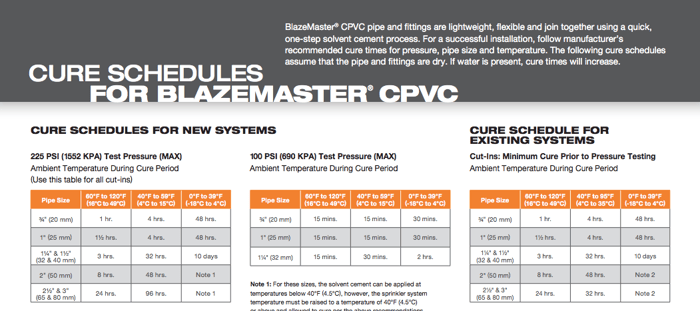Recommended CPVC solvent cement cure times for fire sprinkler installations
As CPVC piping — the specialised material that powers BlazeMaster® Fire Protection Systems — is a polymer, it requires a solvent cement to join the piping with the fitting.
This means that a large part of getting the system up and running seamlessly is the joining process. BlazeMaster CPVC pipes and fittings have a very simple one-step joining system, which can buy installers time during the installation process in comparison to steel, leading to significant cost savings. The solvent joining process also results in a permanent chemical bond, resulting in a robust, sturdy connection that is stronger than the pipe or fitting alone.
It’s essential, therefore, for installers to be aware of the time it takes for solvent cement to cure before testing the system. For best practice when joining the piping, we recommend using BlazeMaster one-step solvent cement for optimum cure times during your installation. Take a look at our installation walkthrough video to see an example of how this process is carried out.
Read on for guidance on solvent cement cure times and installation advice for a BlazeMaster CPVC piping system.
The science behind solvent curing
To dismiss a common misconception, curing is not similar to glueing, where an additional layer is required for two materials to stick. Instead, solvent cement is used to unbind the molecules on the thermoplastic material when first applied, which then enables the molecules to fuse together with another solvent-soaked thermoplastic fitting.
It takes time for this binding process to happen and for the newly formed joint to connect and harden. There are unique benefits, however, that come through binding through solvents, as the materials form a strong chemical bond that is far more reliable than if the fittings were simply glued together. This is why it’s best to ensure a system is given sufficient time to cure, as weakened joints can lead to leaks and damage.
What can affect cure times?
There are a number of factors that can alter solvent cement cure times, which can span from a few minutes to a number of days. These include:
Pipe size
For BlazeMaster Fire Protection Systems, the smaller the pipe, the faster the drying time of the solvent cement. For larger pipe diameters, a thicker body of solvent cement is required to ensure a stronger hold.
Ambient temperature
The higher the temperature, the faster the solvent cement will fuse the piping.
Particular care should be exercised when installing or fusing BlazeMaster CPVC systems in temperatures below 4°C and extra time must be allowed for the solvent cement to set and cure in cold weather (link to blog).
At temperatures above 27°C, ensure both surfaces to be joined are still wet with cement during assembly, as higher temperatures can accelerate the evaporation of the solvents in the cement.
Humidity
The drying time for solvent cement on CPVC will also depend on the humidity within the atmosphere, with a faster drying time in drier environments. Be sure that the surface of the piping is also dry before applying solvent cement. To be safe in humid conditions, add 50% of the recommended cure time when installing BlazeMaster CPVC.
BlazeMaster CPVC solvent cement cure time chart
After joining the pipes and fittings using solvent cement, allow up to 5 minutes without stressing the joint to allow it to set.
Once an installation is completed and the system is cured, it should be pressure tested to ensure that trapped air is removed. Trapped air can jeopardise any piping system, regardless of the material used.
The system should be left to cure for the following times before pressure testing to a maximum of 14 bars:

Installation advantages with BlazeMaster CPVC piping
BlazeMaster CPVC piping offers significant time savings — and therefore cost savings — during the installation process when compared to steel, particularly during retrofit installations. The installation process is neat and fast, requiring only hand tools and no heavy equipment or welding torches as are required for steel systems. In the example of the Callow Mount tower block installation, fitting a CPVC fire sprinkler took an average of one day per flat and tenants were said to be pleased with little noise and disturbance, with all 47 residents staying within the building during installation.
BlazeMaster CPVC piping has been a tried, trusted and certified material for fire sprinkler systems for decades, in projects including schools, care homes, residential tower blocks, retrofits and new builds. Our aim is to educate the market and show that retrofitting and applying fire sprinklers for new and current builds can not only be cost-effective and easy, but absolutely essential.
Learn more about the benefits of fitting a fire sprinkler system that you can rely on with BlazeMaster Fire Protection Systems, with reduced costs, quicker installation times and environmental benefits, by downloading the free guide to CPVC today.
Get informed about the benefits of BlazeMaster CPVC piping with our free guide.

